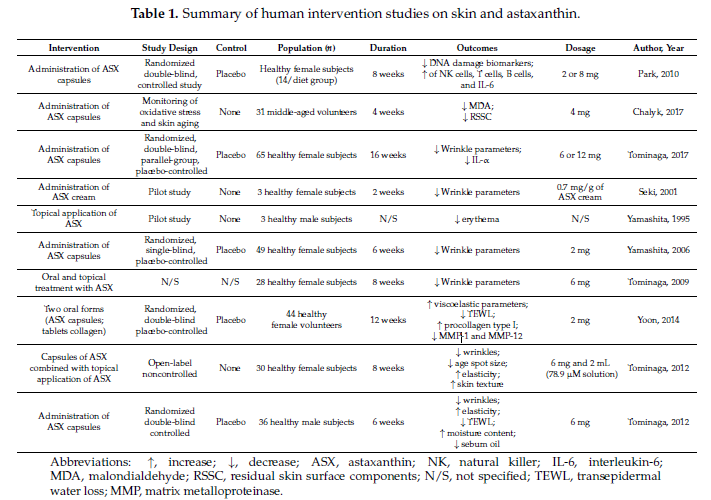
Introduction
Astaxanthin (ASX) is a xanthophyll carotenoid from bacteria, microalgae, and yeasts. Its major source is the microalgae Hematococcus pluvialis. It is known for its commercial application in various industries especially nutraceuticals and pharmaceuticals.
ASX functions to provide pigmentation, protection against ultraviolet (UV) light effects, communication, immune response, reproductive capacity, stress tolerance, and protection against oxidation of macromolecules in marine animals.
The mechanisms through which astaxanthin exert its benefits are still unknown. Some theories on its role in skin homeostasis have been proposed. These include astaxanthin’s photoprotective, antioxidant, and anti-inflammatory effects.
Relevance
Due to ASX’s role in skin physiology, evidence for its health benefits and applications in dermatology as a nutraceutical is sought. There is also evidence for ASX’s anticancer, antidiabetic, anti-inflammatory, antioxidant, neuro-, cardiovascular, ocular, and skin-protective effects. Further, ASX has exhibited biological property to achieve effective skin cancer chemoprevention.
Objectives
This technical review article summarizes the benefits of astaxanthin especially in skin health. It also identifies the potential mechanism that astaxanthin exert to the body and its clinical implications.
Highlights
Skin-Protective Mechanisms of Astaxanthin
Antioxidant Activity
Human skin aging and damage is a product of reactive oxygen species (ROS) from oxidative stress and exposure to ultraviolet (UV) light. Astaxanthin has been postulated to pose some photoprotective effects through its antioxidant property. It inhibits ROS formation and regulates oxidative stress-response enzymes such as heme-oxygenase-1 (HO-1).
Astaxanthin also has been shown to be superior compared to other carotenoids such as beta-carotene and canthaxanthin in terms of protecting human dermal fibroblasts. This is evidenced by comparative studies done among the carotenoids.
Aside from protecting the skin from sun damage, ASX has also been shown to delay the progression of burn wounds in a rat model. This can be explained by the ROS-inhibiting property of ASX and regulation of free radical production.
Anti-Inflammatory Properties
Oxidative stress has long been associated with chronic inflammation. Moreover, extensive UV light exposure has deleterious effects to the skin in that it releases proinflammatory mediators.
Astaxanthin has been shown to decrease UV-induced reactive nitrogen species production, inflammatory cytokines, and cell death in skin cells. Inflammatory mediators such as inducible nitric oxide (iNOS), cyclooxygenase (COX)-2, prostaglandin E2 have decreased after keratinocyte exposure to ASX.
The ability of ASX to inhibit iNOS has important implications for developing drugs or mechanisms to combat chronic inflammatory skin disorders like psoriasis and atopic dermatitis. Furthermore, ASX blocks the nuclear factor kappa B activation in human skin cells, this property offers a new strategy for treating inflammatory skin diseases.
Immune-Enhancing Effects
ASX has been demonstrated to enhance immunoglobulin production of human lymphocytes through in vitro studies. In vivo, ASX’s immunomodulatory properties have been shown through enhancement of cell-mediated and humoral immunity of dogs and cats.
ASX also helps regulate natural killer (NK) cells by increasing their cytotoxic activity. This helps serve as an immune surveillance versus tumours and virus-infected cells. Antibodies of mice have increased following ASX exposure.
Effects on Skin Damage
Matrix metalloproteinase (MMP) is an enzyme that degrades cells and cause damage. ASX has been shown to suppresses cell damage caused by free radicals and induction of MMP-1 in skin after UV irradiation through in vitro studies. Moreover, MMP expression by cells like macrophages and chondrocytes has been inhibited by ASX as evidenced by studies.
ASX has been shown to speed up wound healing especially in full-thickness dermal wounds in mice studies. This is evidenced by an increase in the production of collagen and fibroblast growth factor. Further, collagen content has increased following the MMP-inhibiting property of ASX.
Effects on DNA Repair
DNA is damaged by UV radiation. ASX minimizes the damage and improves DNA repair capacity. This can be explained by the inhibition of the UV-induced DNA damage. Moreover, ASX increases the expression of oxidative stress-responsive enzymes catalysing oxidative radicals.
Safety & Bioavailability
The safety of ASX has been set by European Food Safety Authority (EFSA) on Additives and Products or Substances used in Animal Feed (FEEDAP) to a daily intake of 2.38 mg per day for an average-weighting man (70kg) or approximately 0.034 mg/kg. ASX from H. pluvialis has been used as a food-colouring agent in salmon feeds and as a human dietary supplement in Europe, Japan, and the USA.
It is known that lipid soluble substances are better absorbed by the body. Carotenoids are lipid soluble and so is astaxanthin being a carotenoid. Greater amount of astaxanthin is absorbed when prepared as an oil-based formulation. Food intake increases the absorption of ASX while smoking reduces its half-life.
Evidence from Human Clinical Trials
There is a multitude of clinical trials showing different health benefits of astaxanthin. Table 1 from Davinelli et al’s review in 2018 summarizes the different clinical trials on astaxanthin and its potential benefits in skin health.

Conclusion
Currently, there is no direct recommendation from the EFSA or FDA regarding ASX’s therapeutic indication, although it appears to be safe. Further studies are needed to fully understand the role of ASX in skin health.
It is important to note that ASX inhibits enzymes such as collagenases and MMP and it also reduces inflammation resulting to antiwrinkle and antioxidant effects. Its cytoprotective mechanisms make it a promising compound in dermatology.
Reference:
S. Davinelli, M.E. Nielsen, G. Scapagnini, Astaxanthin in Skin Health, Repair, and Disease: A Comprehensive Review. MDPI Journal-Nutrients, Licensee MDPI, Basel, Switzerland. Received: 26 March 2018; Accepted: 19 April 2018; Published: 22 April 2018, Accessed at (http://www.mdpi.com/journals/nutrients)
This article was originally posted in Pharexmedics.com